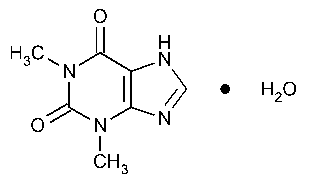Theophylline
1H-Purine-2,6-dione,3,7-dihydro-1,3-dimethyl-,monohydrate.
Theophylline monohydrate [5967-84-0].
Anhydrous 180.17 [58-55-9].
»Theophylline contains one molecule of water of hydration or is anhydrous.It contains not less than 97.0percent and not more than 102.0percent of C7H8N4O2,calculated on the dried basis.
Packaging and storage—
Preserve in well-closed containers.
Labeling—
Label it to indicate whether it is hydrous or anhydrous.
Identification—
A:
Infrared Absorption á197Kñ.
B:
The retention time of the major peak in the chromatogram of the Assay preparationcorresponds to that in the chromatogram of the Standard preparation,both relative to the internal standard,as obtained in the Assay.
Melting range á741ñ:
between 270 and 274
and 274 ,but the range between beginning and end of melting does not exceed 3
,but the range between beginning and end of melting does not exceed 3 .
.
Acidity—
Dissolve 500mg in 75mLof water,and add 1drop of methyl red TS:not more than 1.0mLof 0.020Nsodium hydroxide is required to change the red color to yellow.
Loss on drying á731ñ—
Dry it at 105 for 4hours:the hydrous form loses between 7.5%and 9.5%of its weight,and the anhydrous form loses not more than 0.5%of its weight.
for 4hours:the hydrous form loses between 7.5%and 9.5%of its weight,and the anhydrous form loses not more than 0.5%of its weight.
Residue on ignition á281ñ:
not more than 0.15%.
Organic volatile impurities,Method Vá467ñ:
meets the requirements.
Solvent—
Use dimethyl sulfoxide.
Assay—
Buffer solution—
Transfer 2.72g of sodium acetate trihydrate to a 2000-mLvolumetric flask,add about 200mLof water,and shake until dissolution is complete.Add 10.0mLof glacial acetic acid,dilute with water to volume,and mix.
Mobile phase—
Transfer 70.0mLof acetonitrile to a 1000-mLvolumetric flask,dilute with Buffer solutionto volume,and mix.Degas,and filter before using.Make adjustments if necessary (see System Suitabilityunder Chromatography á621ñ).
Internal standard solution—
Transfer about 50mg of theobromine,accurately weighed,to a 100-mLvolumetric flask,dissolve in 10.0mLof 6Nammonium hydroxide,dilute with Mobile phaseto volume,and mix.
Standard preparation—
Dissolve an accurately weighed quantity of USP Theophylline RSin Mobile phase,and dilute quantitatively,and stepwise if necessary,with Mobile phaseto obtain a solution having a known concentration of about 1mg per mL.Transfer 10.0mLof this solution to a 100-mLvolumetric flask,add 20.0mLof Internal standard solution,dilute with Mobile phaseto volume,and mix to obtain a solution having a known concentration of about 0.1mg of USP Theophylline RSper mL.
Assay preparation—
Transfer about 100mg of Theophylline,accurately weighed,to a 100-mLvolumetric flask,add about 50mLof Mobile phase,shake by mechanical means until solution is complete,dilute with Mobile phaseto volume,and mix.Transfer 10.0mLof this solution to a second 100-mLvolumetric flask,add 20.0mLof Internal standard solution,dilute with Mobile phaseto volume,and mix.
Chromatographic system
(see Chromatography á621ñ)—The liquid chromatograph is equipped with a 280-nm detector and a 4-mm ×30-cm column that contains packing L1.The flow rate is about 1.0mLper minute.Chromatograph the Standard preparation,and record the peak responses as directed for Procedure:the resolution,R,between the theophylline and theobromine peaks is not less than 2.0,the tailing factor for the theophylline peak is not more than 2.0,and the relative standard deviation for replicate injections is not more than 1.5%.
Procedure—
Separately inject equal volumes (between 10µLand 25µL)of the Standard preparationand the Assay preparationinto the chromatograph,and measure the peak responses for the major peaks.The retention time of theophylline relative to that of theobromine is about 1.6.Calculate the quantity,in mg,of C7H8N4O2in the portion of Theophylline taken by the formula:
1000C(RU/RS),
in which Cis the concentration,in mg per mL,of USP Theophylline RSin the Standard preparation,and RUand RSare the response ratios of the theophylline peak to the internal standard peak obtained from the Assay preparationand the Standard preparation,respectively.
Auxiliary Information—
Staff Liaison:Karen A Russo,Ph.D.,Scientist
Expert Committee:(PA1)Pharmaceutical Analysis 1
USP28–NF23Page 1896
Pharmacopeial Forum:Volume No.29(5)Page 1586
Phone Number:1-301-816-8379
